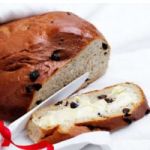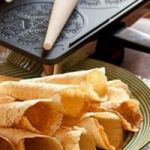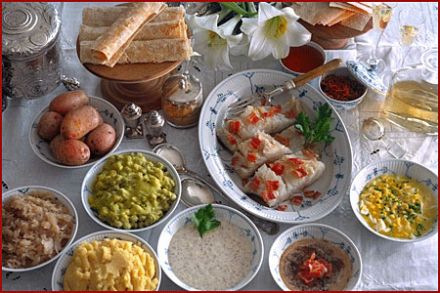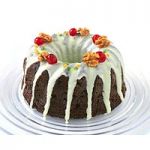 |
Christmas in Norway
In preparation for the holidays, the house is given a thorough cleaning from top to bottom and enough wood is chopped to keep the fires burning for at least the first three days of Christmas. The Christmas tree is brought in and decorated. In some places, for nostalgic reasons, people still use horse and sleigh, and the tinkle of sleigh-bells can be heard amidst the snow-clad trees. It is a season of welcoming, of warm light streaming out of open doors as guests are received, and of hospitality even to strangers, in keeping with the belief that nobody should be alone at Christmas. One old Norwegian tradition (called going "julebukk" or "Christmas goat") has children dress up in costume and go from farm to farm to be given cakes and sweets. Though its origins are obscure, "julebukk" certainly dates back to medieval times.
In the country it is customary on Christmas Eve to make a trip to the barn with a bowl of porridge for the "nisse", the gnome who, according to superstition, is the protector of the farm. Nowadays this ceremony is performed for the benefit of the children, but grandmother may have had the uneasy feeling that the little fellow actually exists. But he is not the only one to be given a treat; the "julenek", a sheaf of oats for the birds, is mounted on a pole, and even the farm animals get a special Christmas ration.
Afterwards, the family sits down for the traditional meal. To a foreigner the menu may seem to contrast strangely with the festive occasion, since the traditional fare is a hold-over from pre-Reformation times when Christmas Eve was a day of fast and abstinence. The dinner includes porridge and fresh cod, if available, or "lutefisk," cod soaked in a lye solution which gives it a unique flavor and soft texture. Traditionally lutefisk is served boiled, accompanied by cooked split peas, steamed potatoes, mustard and goat's cheese. In northwestern Norway it is often prepared as a purée.
These days, however, the Christmas meal is rounded off with a variety of dishes that are less austere. Norwegians may prefer to treat themselves to snowcock with shallots, cream and goat's cheese; salmon; or a variety of pork dishes.
The tradition of pork butchery dates back to pagan times when a pig was sacrificed to Frøy, the god of fertility, during the Joulu celebrations. Spit-roasted, it was later shared among all the members of the community during a big banquet. To this day, it's traditional to butcher a pig, though the ways in which the pork is prepared depends on family or local preference: roast piglet, pressed pork, roast pork with sour cabbage, smoked ham, pickled pig's feet… In the west of the country, preference is given instead to ribs of mutton served with mashed kohlrabi, while easterners like to have them grilled with crispy rind.

Norwegians retain a great attachment to the tradition of the seven Christmas cakes and feel obligated to make them themselves. While in other countries it is common to purchase cakes from the baker, this would be unthinkable in Norway. The most typical cake is "julekake," a sweet bread studded with raisins, candied citrus peel and cardamom, whose fragrance fills the house.

Krumkake are thin pancakes that are rolled into a cone while still hot. The name literally means "crumb cake" since they are so crumbly. Generally served filled with cream or fruit, they are a special treat for the Christmas season.

In the old days it was made on the farms, though in modern times it is made by breweries. The Juleøl tradition can be traced back to the time when horns filled with beer during the Joulu festivities were dedicated to the Norse gods Odin, Frøy and Njord. But when modern-day Norwegians time lift their glasses in the traditional Scandinavian "skål" (pronounced scawl), they likely give little thought to their Viking forebears who hoisted the sacrificial beer to drink for peace and a good year to come. After beer, it is aquavit that goes best with the Christmas meal. It could be said that this potato-based liquor is the Norwegian national drink. The well-known Norwegian Linie-akevitt is shipped to Australia and back to mature in the perfect way and to achieve the finest flavour. It gets the name Linie because it crosses the equator (The Line) on its journey.
While in many countries the holiday festivities end on Epiphany, in Norway they continue until January 13, the twentieth day of Christmas, and the feast day of St. Canute. Then, according to a saying, "twentieth-day Canute drives away Christmas."


-

 Recipes
Recipes
-

 Products
Products
-

 Entertaining
Entertaining
-

 Chefs
Chefs
-

 Hints & Tips
Hints & Tips
-

 Glossaries
Glossaries









